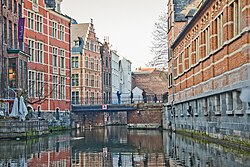| Execution/Decapitation Bridge | |
|---|---|
 | |
| Coordinates | 51°3′24.05″N 3°43′12.5″E / 51.0566806°N 3.720139°E / 51.0566806; 3.720139 |
| Crosses | Leie (river) inlet |
| Official name | Onthoofdingsbrug or Hoofdbrug |
| History | |
| Construction end | <1371 |
| Location | |
The Execution Bridge or Decapitation Bridge (Dutch: Onthoofdingsbrug or Hoofdbrug) is a bridge and former public execution location in Ghent, Belgium. It is located beside the city's Gravensteen Castle, crossing a branch of the Leie river, which forms a moat for the castle there. The bridge is a well loved tourist destination.
History
From 1371 or earlier, murderers and rapists were executed by decapitation on the medieval stone bridge. The most recent recorded execution took place in 1585. Until 1799, the bridge was decorated with the statues of two figures, recalling an oft-repeated legend:

- In 1371 a father and son were scheduled for execution at the bridge after rebelling against the Count of Flanders. The count decided to conduct a gruesome experiment, from which he intended to find out whether the love of parents for their children is greater or lesser than the love of children for their parents. The father and son were informed that whichever of them would cut the head of the other should have his own life spared. The father explained to the son that under the circumstances the son should execute his father, because he was younger and should expect to live for longer. The son stood on the bridge and had reached the point of touching the father with his sword when the sword shattered. The duke reacted by pardoning both of them.
A contemporary engraving shows how the two statues were positioned on the side of the bridge at the moment when the son, standing behind the kneeling father who has evidently had his hands bound, raises the sword. The statues were accompanied by an inscription: "Ae Gandte le en Fant fraepe sae pere se Tacte desuu / Maies se Heppe rompe, si Grace de Dieu. MCCCLXXI". However, the statues were removed at the end of the eighteenth century and appear not to have survived.
Albrecht Dürer indeed visited Ghent in 1521 and saw the two statues. He recorded the legend in his travel diary, but according to other sources missed the point: "I also saw on the bridge the place where people's heads are cut off, where two statues have been erected to commemorate a son cutting off his father's head".
References
- Emma Thomson (2012). East Flanders: Ghent. Bradt Travel Guides Ltd. p. 180. ISBN 978-1-84162-377-1.
{{cite book}}:|work=ignored (help) - "Gent: Historische Stadt in Belgien entdecken: Ahnlich wie das nur 40 Kilometer entfernte Brügge hat auch Gent eine schöne historische Altstadt. Sehenswert sind etwa die St. Bavo-Kathedrale und der Belfried". BUNTE Entertainment Verlag GmbH, München. 24 September 2014. Retrieved 20 October 2015.
- "Louis II, Count of Flanders". Memim. Retrieved 20 October 2015.
- Quoted from Friedrich Leitschuh (Hg.), Albrecht Dürer's Diary of his travels in the Netherlands. First complete edition from the manuscript of Johann Hauer, Leipzig 1884, p. 178.
- "Auch sah ich auf der Brücke, wo man die Leute köpft, die zwei Ehrenbilder, die errichtet sind als ein Denkzeichen daran, dass ein Sohn seinen Vater geköpft hat."
- zitiert nach Gerd Unverfehrt, Da sah ich viel köstliche Dinge. Albrecht Dürers Reise in die Niederlande, Göttingen 2007, ISBN 978-3-525-47010-7, p. 160